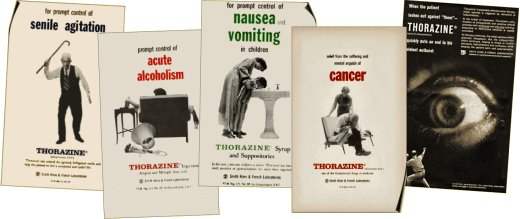One of the nicest things about being retired is that I can think about what I want to think about. And it’s obvious that my response to the Individual Resiliency Training [IRT] component of the RAISE project has hit one of those things that I’ve wanted to muse about for a long time. I realize I’m off on a personal tangent of my own here, but a blog is thinking out loud, and it’s what I’m thinking about right now.
So in a further comment…, I was chasing down the experiment of George Brooks in the 1950s in getting chronic mental patients out of Vermont’s State Mental Institution and into the community, and the follow-up studies that went on for decades. Just a note of historical interest. The way the Vermont study got started was with a study of Thorazine® [Chlorpromazine], the first antipsychotic. They had given the new drug to everyone in their "back ward," and 178 responded enough to be discharged from the hospital. The "back ward" in those days meant something akin to "hopeless," so this response seemed even bigger than a minor miracle then. Thorazine® was the blockbuster of the day, and this was before the FDA was tasked to approve either efficacy or indication, attested by the ads of the day – one step this side of the patent medicines:

But that study left behind 269 patients who weren’t helped enough by the Thorazine® to be released. So Dr. Brooks took another approach [again, this was also a time before the Community Mental Health Movement].
by Harding CM, Brooks GW, Ashikaga T, Strauss JS, Breier A.American Journal of Psychiatry. 1987 144[6]:718-26.
The authors report the latest findings from a 32-year longitudinal study of 269 back-ward patients from Vermont State Hospital. This intact cohort participated in a comprehensive rehabilitation program and was released to the community in a planned deinstitutionalization effort during the mid-1950s. At their 10-year follow-up mark, 70% of these patients remained out of the hospital but many were socially isolated and many were recidivists. Twenty to 25 years after their index release, 262 of these subjects were blindly assessed with structured and reliable protocols. One-half to two-thirds of them had achieved considerable improvement or recovery, which corroborates recent findings from Europe and elsewhere.
by Harding CM, Brooks GW, Ashikaga T, Strauss JS, Breier A..American Journal of Psychiatry. 1987 144[6]:727-735.
The authors present the findings from a long-term follow-up study of 118 patients from Vermont State Hospital who, when rediagnosed retrospectively, met DSM-III criteria for schizophrenia at their index hospitalization in the mid-1950s. The patients were studied with structured, reliable, multivariate instrument batteries by raters who were blind to information in their records. The rediagnostic process is described, and results of the follow-up are presented. Outcome varied widely, but one-half to two-thirds of the sample had achieved considerable improvement or recovered, in contrast to statements in DSM-III that predict a poor outcome for schizophrenic patients.
by DeSisto MJ, Harding CM, McCormick RV, Ashikaga T, Brooks GW..British Journal of Psychiatry. 1995 167[3]:331-338.
BACKGROUND: This study compared long-term outcome of serious mental illness in two states using a matched design to assess psychiatric rehabilitation programmes; Vermont subjects participated in a model psychiatric rehabilitation programme, while the Maine group received more traditional care.METHOD: Maine and Vermont subjects [n = 269] were matched by age, sex, diagnosis, and chronicity. Demographic, illness, and life history information were abstracted from hospital records by clinicians blind to outcome. DSM-III criteria were applied retrospectively. Outcome was assessed by clinicians blind to history.RESULTS: Vermont subjects alive at follow-up [n = 180] were more productive [P < 0.0009], had fewer symptoms [P < 0.002], better community adjustment [P < 0.001] and global functioning [P < 0.001] than Maine subjects [n = 119].CONCLUSIONS: Outcome differences may be due to Vermont’s model programme and a policy of allowing an earlier opportunity for community life.
by DeSisto M, Harding CM, McCormick RV, Ashikaga T, Brooks GW..British Journal of Psychiatry. 1995 167[3]:338-42.
BACKGROUND: This paper supplements the cross-sectional outcome comparisons of the companion paper by providing a brief account of the longitudinal courses of the Maine and Vermont samples across several outcome domains.METHOD: A Life Chart method was used to document changes in individual lives over the domains of residence, work, income source, and use of community resources over a 20-year period. Reliability studies between states were conducted.RESULTS: Throughout much of the period, more Vermont subjects lived independently, were working, and were less likely to use community resources compared to Maine subjects.CONCLUSIONS: Differences in both policies and programmes contributed to course differences between the groups. System characteristics that may lead to better outcomes are discussed.

Dr. Brooks initial use of Thorazine® [shortly after it became available] allowed him to release 40% of his back ward patients from the hospital. But he was dealing with a number of problems – the conditions that had brought the patients to the hospital in the first place; the condition they had developed by having been there for a long time that came to be called institutionalization; and the impossibility of separating these things with any precision.
I think my remarks in another IRT prequel… apply here as well. I was saying that we use Resiliency as a noun, as if it represents an entity. I claimed that it’s really more an adverb, a tautology. We’ve elevated observations of behaviors to the level of an existent. We could say the exact same thing about Schizophrenia and Institutionalization. Both are based on observations of what certain people do [or don’t do], but are talked about as things. It’s the point made repeatedly by Thomas Szasz and his followers – The Myth of Mental Illness. The other side of the coin is in our very words – Dis-ease, Ill-ness, Sick-ness – words that define the domain of medicine in terms of how people feel, not something they have. One can only think about that conundrum for so long. I think 40 years must be the limit because that’s how long it has been for me, and I repeatedly glaze over now with ‘Is Schizophrenia one disease? or many diseases? or even a disease at all?‘. Fortunately for the inhabitants of the Vermont Mental Institution up there in that picture and to his credit, Dr. Brooks didn’t get lost in such musings, which was Dr. Steingard’s original point in mentioning these papers: "Brooks brought in the patients and asked them what THEY needed in order to be able to be well enough to leave the hospital."
Thank you for honoring this important work.